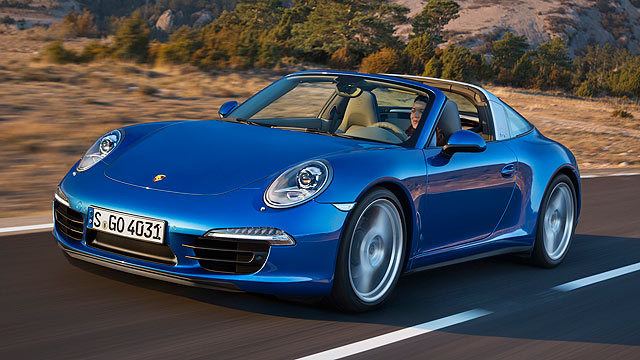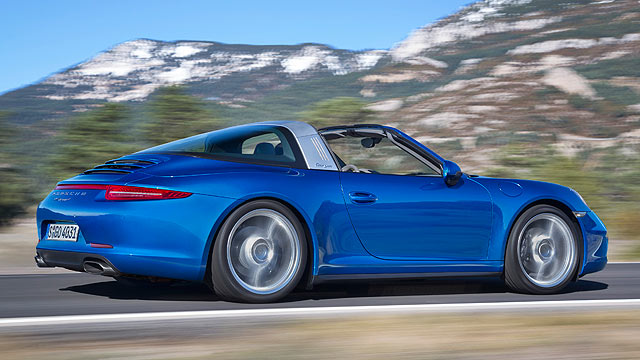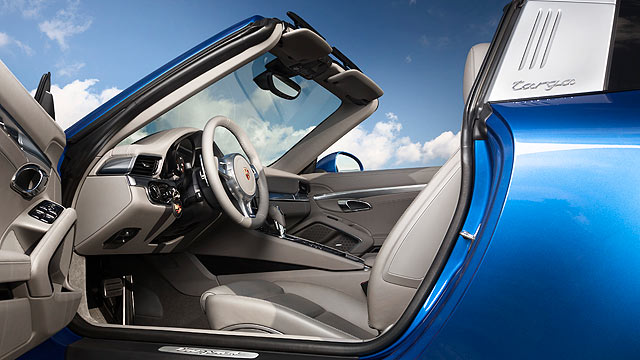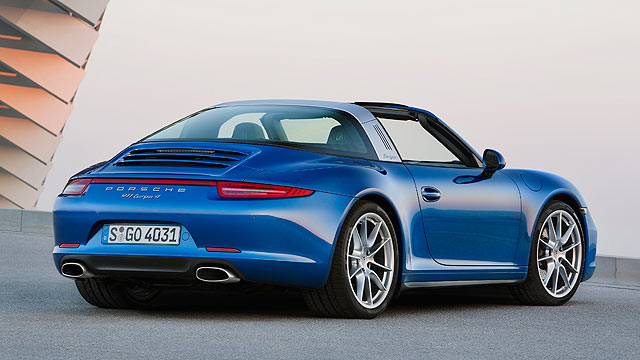
- Third bodystyle for Porsche 911 brings back classic Targa semi-cabrio look
- Ingenious roof operation and appealing styling enhance core 911 appeal
- Priced from £86,281 | On sale May 2014
Richard Aucock | April 2014
British Porsche designer Tony Hatter is pleased Porsche’s returned to the classic look for its new 911 Targa. But it wasn’t the work of a moment. Although sketching the principals of the high-tech roof was straightforward, getting it to work was another matter. “How do you get the soft-top roof over the B-pillar and behind the rear seats?” By making the glass rear window hinge up, that’s how. Ingenious.
The result is street theatre that automates something that was a manual operation on the classic Targa from its launch in 1965 to its demise in 1993. This need for ease of use is one of the reasons Porsche switched the Targa to a less appealing ‘panoramic glass sunroof’ look in the 1990s. Leaks were another, admits Hatter. This one, he promises, doesn’t leak.
It does look fantastic, though. While the original Targas were cool, the 964-era cars were a bit heavy-handed. This 991 Targa is more elegant than the lot of them, with its sleek polished B-pillar and large glass rear really making it stand out. Using the wide arch body helps further enhance the muscular stance. It’s much more modern and appealing than that other open-roof 911 alternative, the Cabriolet.
It’s a car for the rich, though. Prices start at over £86,000, because Porsche has made it four-wheel drive only, and because the Cabriolet it’s derived from is appreciably pricier than the already steep 991 coupe. The Targa 4S is over £96,000: add on the PDK and PASM that most customers are expected to and you have a £100,000 car. Most 991 Targas will be.
Good job it’s not all show and no go, then.
What is the 2014 Porsche 911 Targa like to drive?
The trick with an open-roof car is to lessen the extent to which it suffers in comparison with the stiff, sharp coupe. The Cabriolet isn’t bad in this respect and the Targa, which is 15% stiffer, is a little better still. It can’t deliver the racecar rigidity of a 911 coupe but it’s hardly a soggy mess – it is still a Porsche 911 after all.
You notice the lack of stiffness in some extra trim noise from the rear and the odd slight shimmy through the body, rather than any serious structural shudders. To be honest, you notice the extra weight more (this is 40kg heavier than the Cabriolet), because the Targa isn’t quite as incisive to turn in as the coupe, nor as alert in its direction changes.
Even there, we’re talking degrees – but the really obvious penalty is found in driving the base Targa 4 car. The 3.4-litre motor simply doesn’t have enough torque low down in the rev range to give this car a sporting feel if you’re lazy with the gearbox. Not a factor, will say some; simply keep the gears moving or choose easy-shift PDK to experience the smooth high-rev howl.
Maybe, but we and nearly 8 in 10 customers say you’d be much better off choosing the Targa 4S. This 400hp motor is much more drivable at low revs and even more thrilling at high revs. It’s a seriously fast car – we forget how potent even regular 911s are – and the deeper, more traditional sound it makes is also more appealing.
The Targa 4S also comes with PASM as standard and it’s this that helps make the 911 Targa ride with so much integrity. The Italian launch roads were horrendous but the car coped brilliantly, absorbing surface harshness with real talent. It’s still firm, of course, as it’s still a sports car, but technology has ensured it’s one with no little talent. Top tip: PASM is a must-have option on the Targa 4…
Is the Porsche 911 Targa a Cabriolet for coupe drivers?
For many Porsche 911 coupe drivers, a Cabriolet is an absolute no-no. The slight softness in the drive may not actually be the big issue: the white loafer image of the Cabriolet probably is. Enthusiasts buy 911 coupes, poseurs buy 911 Cabriolets – even though some of those enthusiasts might actually quite like a bit of open-roof action.
Enter the Targa. A cool new 911 that’s named after a classic Italian motor race (and whose name has been trademarked by Porsche since 1965), which looks different and which has been designed as a modern retro addition to complement the classic sports car 911. What’s not to like?
Particularly as the roof operation is genius. It takes 19 seconds and sees the rear glass screen hinge up and the canvass section fold into a z-shape over the B-pillar and behind the rear seats. Like all the best 911s, it’s without compromise and still packed with practicality: you can even open the rear glass separately to drop luggage into the section behind the seats.
Oh, and it won’t let you bend another car unintentionally. The roof folds out quite far from the car when being operated, almost certainly close enough to another car parked behind to leave a nice dent in the bonnet. No worries, says Porsche – parking sensors are standard and they’ve been programmed to account for the roof mechanism. If there’s not enough space, it’s not going down…
There’s something else that even 911 Cabriolet drivers will like; the extra refinement when the roof is down. Uncomfortable buffeting is kept in check even at motorway speeds and while it may get rather loud when you’re really pressing on, conversation is fine in normal use. It’s a convertible that doesn’t offer full exposure but may be used roof down that bit more as a result.
MR VERDICT: Porsche 911 Targa
Porsche 911 fans will celebrate the rearrrival of the Targa. The aimless previous few generations have gone and it’s back to the classic look – which, thanks to its two decades away from the market, now looks cooler than ever. A retro rebirth we approve of.
Much as we love the coupe, we’d consider one: there are dynamic penalties but they’re not significant enough to detract from the appeal of the car overall. The price is the biggest issue – Porsche will be hoping the appeal of a standout new 911 body derivative is enough to justify it. We hope so: it’s a lovely thing to see out on the road.
Rivals
- Porsche 911 Cabriolet
- Mercedes-Benz SL
- BMW 6 Series Convertible
- Jaguar F-Type Roadster
- Aston Martin V8 Vantage Roadster
Specification
Engine 3.4-litre flat-six, 3.8-litre flat-six
Drivetrain Four-wheel drive, seven-speed manual/PDK gearbox
Prices from £86,281
Power 350hp/400hp
Torque 287lb ft/324lb ft
0-62mph 4.2-5.2secs
Top speed 175-183 mph
MPG 28.2-32.4mpg
CO2 204-237g/km


